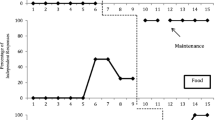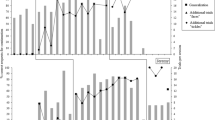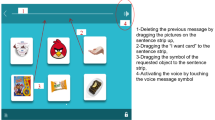Abstract
This study evaluated the effects of within stimulus prompting and prompt fading to teach four preschool children with autism picture symbol discrimination using an iPad® and the Proloqu2Go application as a speech-generating device. Participants were taught to discriminate between a progressively more complex field of picture-symbols depicted on the screen of an iPad with a five-phased training procedure. All participants acquired discrimination between picture-symbols while using the iPad to mand for preferred items in a field of four picture-symbols. The results provide tentative support for a procedure to teach children with autism to discriminate between picture symbols while manding using a handheld speech-generating device.

Similar content being viewed by others
References
Andermeier, K., Schlosser, R. W., Luiselli, J. K., Harrington, C., & Carter, B. (2008). Effects of iconicity on requesting with the Picture Exchange Communication System in children with autism spectrum disorder. Research in Autism Spectrum Disorders, 2, 430–446.
Bondy, A., & Frost, L. (1994). The picture exchange communication system. Focus on Autism and Other Developmental Disabilities, 9, 1–19.
Cooper, J. O., Heron, T. E., & Heward, W. L. (2007). Applied behavior analysis (2nd ed.). Upper Saddle River: Pearson.
DeLeon, I. G., & Iwata, B. A. (1996). Evaluation of a multiple-stimulus presentation format for assessing reinforcer preferences. Journal of Applied Behavior Analysis, 29, 519–532.
Gast, D. L. (2010). Single-subject research methodology in behavioral sciences. New York: Routledge.
Kagohara, D. M., van der Meer, L., Ramdoss, S., O’Reilly, M. F., Lancioni, G. E., Davis, T. N., Rispoli, M., Lang, R., Marschik, P. B., Sutherland, D., Green, V. A., & Sigafoos, J. (2013). Using iPods and iPads in teaching programs for individuals with developmental disabilities: a systematic review. Research in Developmental Disabilities, 34, 147–156.
Lindsley, O. (1964). Direct measurement and prosthesis of retarded behavior. Journal of Education, 147, 62–81.
Lorah, E. R., Tincani, M., Dodge, J., Gilroy, S., Hickey, A., & Hantula, D. (2013). Evaluating picture exchange and the iPad as a speech generating device to teach communication to young children with autism. Journal of Developmental and Physical Disabilities. doi:10.1007/s10882-013-9337-1.
MacDuff, G. S., Krantz, P. J., & McClannahan, L. E. (2001). Prompts and prompt-fading strategies for people with autism. In C. Maurice, G. Green, & R. M. Foxx (Eds.), Making a difference: Behavioral intervention for autism (pp. 37–50). Austin, TX: PRO-ED.
Miranda-Linné, F. M., & Melin, L. (1997). A comparison of speaking and mute individuals with autism and autistic-like conditions on the Autism Behavior Checklist. Journal of Autism and Developmental Disorders, 27, 245–264.
Mirenda, P. (2003). Toward a functional and augmentative and alternative communication for students with autism: manual signs, graphic symbols, and voice output communication aids. Learning, Speech, and Hearing Services in Schools, 34, 203–216.
Peeters, T., & Gillberg, C. (1999). Autism: Medical and educational aspects. London: Whurr.
Schreibman, L. (1975). Effects of within-stimulus and extra-stimulus prompting on discrimination learning in autistic children. Journal of Applied Behavior Analysis, 8, 91–112.
Sigafoos, J., O’Reilly, M. F., Schlosser, R. W., & Lancioni, G. E. (2007). Communication intervention. In P. Sturmey & A. Fitzer (Eds.), Autism spectrum disorders: Applied behavior analysis, evidence, and practice (pp. 151–185). Austin: Pro-ed.
Smith, T., Mruzek, D. W., Wheat, L. A., & Hughes, C. (2006). Error correction in discrimination training for children with autism. Behavioral Interventions, 21, 245–263.
Sundberg, M. L. (2008). VB-MAPP Verbal Behavior Milestones Assessment and Placement Program: a language and social skills assessment program for children with autism or other developmental disabilities: guide. Mark Sundberg: Chicago.
van der Meer, L., Sigafoos, J., O’Reilly, M. F., & Lancioni, G. E. (2011). Assessing preferences for AAC options in communication interventions for individuals with developmental disabilities: a review of the literature. Research in Developmental Disabilities, 32, 1422–1431.
van der Meer, L., Didden, R., Sutherland, D., O’Reilly, M. F., Lancioni, G. E., & Sigafoos, J. (2012a). Comparing three augmentative and alternative communication modes for children with developmental disabilities. Journal of Developmental and Physical Disabilities, 24, 451–468.
van der Meer, L., Sutherland, D., O’Reilly, M. F., Lancioni, G. E., & Sigafoos, J. (2012b). A further comparison of manual singing, picture exchange, and speech-generating devices as communication modes for children with autism spectrum disorders. Research in Autism Spectrum Disorders, 6, 1247–1257.
Wetherby, A. M., & Prizant, B. M. (2005). Enhancing language and communication development in autism spectrum disorders: Assessment and intervention guidelines. In D. Zager (Ed.), Autism spectrum disorders: Identification, education, and treatment (3rd ed., pp. 327–365). Mahwah: Lawrence Erlbaum Associates.
Author information
Authors and Affiliations
Corresponding author
Rights and permissions
About this article
Cite this article
Lorah, E.R., Crouser, J., Gilroy, S.P. et al. Within Stimulus Prompting to Teach Symbol Discrimination Using an iPad® Speech Generating Device. J Dev Phys Disabil 26, 335–346 (2014). https://doi.org/10.1007/s10882-014-9369-1
Published:
Issue Date:
DOI: https://doi.org/10.1007/s10882-014-9369-1




